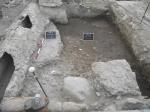Summary (English)
Nora, north-western quarter.
The 2016 excavations aimed to rediscover and check the data that emerged in recent years, with a view to inserting the Small Baths within the context of the quarter.Therefore, investigations continued in the entrance area of the baths (phase II: 4th century A.D.), rediscovering the cobblestone floor, although only in small patches, that was originally in the porticoed area. This portico, open onto the road towards the northern port and later incorporated into the bath complex, was originally paved with cobblestones. It was in use for a long period, as attested by the various interventions to repave the area, all cut by the large sewer that served the Small Baths and was built at the same time as the monumental restructuring (Phase II). The cobblestone paving was slightly humped in order to allow rainwater drainage. It was built on layers of dumped material used to level the terrain, which contained finds datable to the 1st century A.D. (_terminus_ post quem).
The excavations showed that this space was not physically separated from the so-called macellum or Insula A, in the 4th century A.D. phase. Consequently, exploration began in the adjacent room (D10) in order to understand the relationship between the two buildings.
The so-called macellum had a first phase in the Severan period when it functioned as a horreum. When it was enlarged in the 4th century A.D., it incorporated a number of domus facing onto the portico of the port road, which were transformed into shops with dwellings on the upper floor. The connection with the Small Baths was evident, as they were functional precisely to this Insula A, to the south of which the majestic and public seaward baths stood.
The excavations uncovered the roof collapse, parts of the upper walls of the room (D10), and several late interventions (7th century A.D.). This was a temporary timber structure, used after a period of abandonment (6th century A.D.?), attested by a layer of Aeolian sand, which also emerged in other parts of the quarter dating to the same period.
- Bianca Maria Giannattasio - Università degli Studi di Genova
Director
- Arch. Fausto Martino- Soprintendenza per i Beni Archeologici per le province di Cagliari e Oristano
- Maurizia Canepa - Soprintendenza dei beni archeologici per le province di Cagliari e Oristano
Team
- A. Parodi - Università degli Studi di Genova
- M. Grippo - Università degli Studi di Genova
- Simona Magliani- Università degli Studi di Genova
Research Body
- Università degli Studi di Genova, Dipartimento Antichità, Filosofia, Storia (D.A.FI.ST.)
Funding Body
- Università degli Studi di Genova






![Download [PDF]](/excavation/skins/fasti/images/results/download_sml.png)